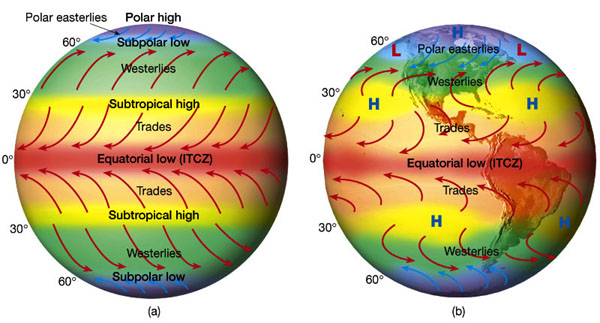| |
In
the zone between about 30°N and 30°S, the surface air flows
toward the equator and the flow aloft is poleward. A low-pressure area
of calm, light variable winds near the equator is known to mariners
as the doldrums. Around 30°N and S, the poleward flowing air begins
to descend toward the surface in subtropical high-pressure belts. The
sinking air is relatively dry because its moisture has already been
released near the Equator above the tropical rain forests. Near the
center of this high-pressure zone of descending air, called the Horse
Latitudes, the winds at the surface are weak and variable. The name
for this area is believed to have been given by colonial sailors, who,
becalmed sometimes at these latitudes while crossing the oceans with
horses as cargo, were forced to throw some overboard to conserve water.
The surface
air that flows from these subtropical high-pressure belts toward the
Equator is deflected toward the west in both hemispheres by the Coriolis
effect. Because winds are named for the direction from which the wind
is blowing, these winds are called the northeast trade winds in the
Northern Hemisphere and the southeast trade winds in the Southern Hemisphere.
The trade winds meet at the doldrums. Surface winds known as westerlies
flow from the Horse Latitudes toward the poles. The westerlies
meet easterlies from the polar highs at about 50-60° N and
S. |
|
